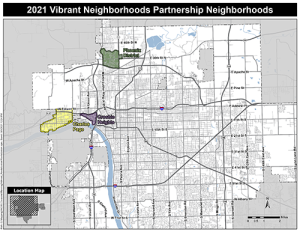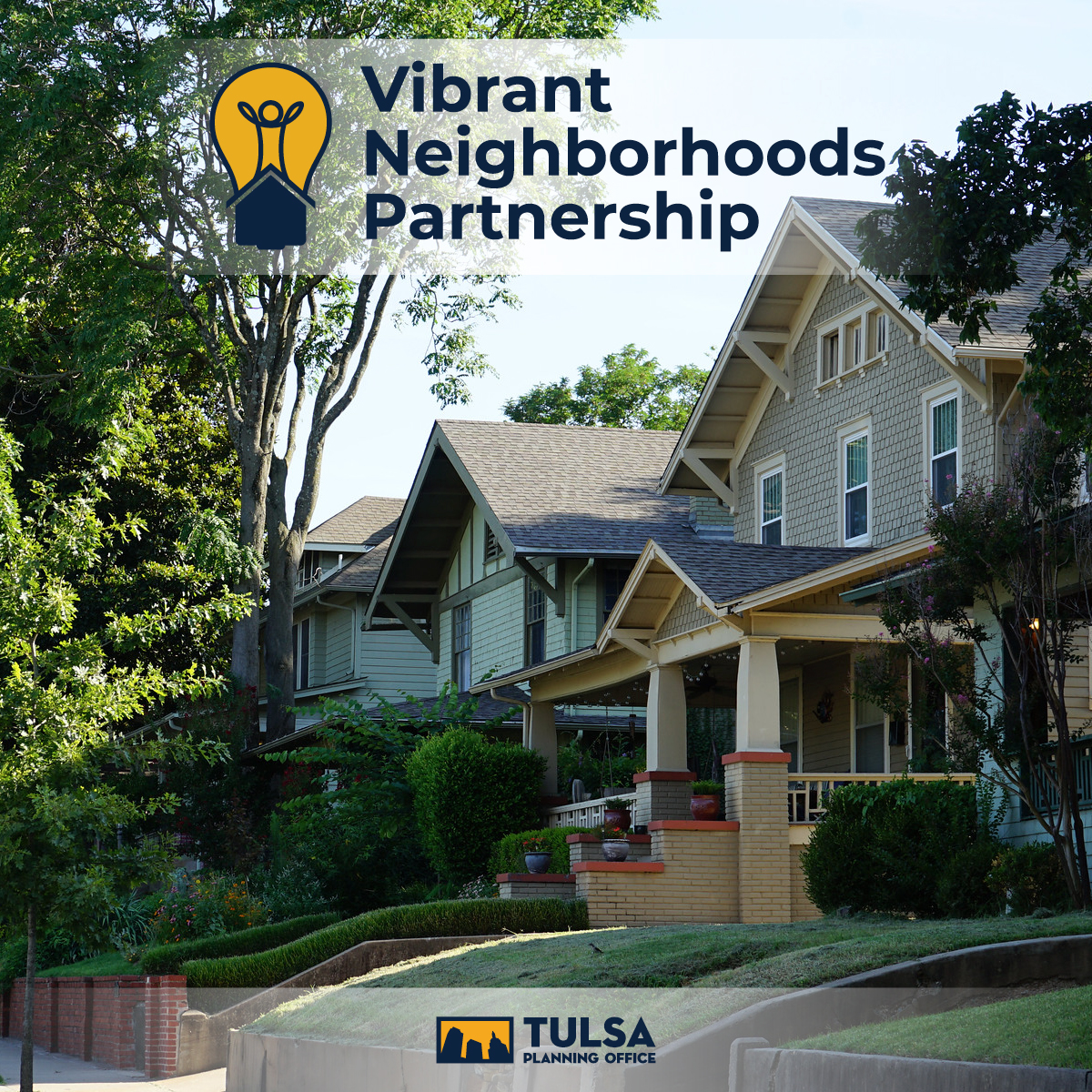Vibrant Neighborhoods Partnership
About the Program
 The Vibrant Neighborhoods Partnership is a community-driven program that improves the quality of life in Tulsa’s neighborhoods. It seeks to holistically improve neighborhood infrastructure and enjoyment through targeted public support and service delivery in collaboration with neighborhood residents.
The Vibrant Neighborhoods Partnership is a community-driven program that improves the quality of life in Tulsa’s neighborhoods. It seeks to holistically improve neighborhood infrastructure and enjoyment through targeted public support and service delivery in collaboration with neighborhood residents.
The goal of the Vibrant Neighborhood Partnership is to bring City departments, community partners, and neighborhood residents together to identify and address key issues through clearly defined actions for a set period of time.
Potential tools and resources to support neighborhoods include:
- Pedestrian and bicycle infrastructure
- Public art, wayfinding, and beautification
- Food access initiatives
- Housing and homeowner support
- After school and youth programming
- Public safety support
Once selected, participating neighborhoods undergo a collaborative planning process with Tulsa Planning Office staff to determine neighborhood goals and strategies for improvement. The program aims to work with the neighborhood to implement desired initiatives for a period of 2-3 years.
Updates for Residents of Crosbie Heights
Neighborhood Association meetings are held the third Thursday of every month virtually.
For a meeting link or more info, contact Jasmine Aaenson-Fletcher at: president.crosbieheights@gmail.com.
 Participating Neighborhoods
Participating Neighborhoods
View a map of neighborhoods participating in the Vibrant Neighborhoods Partnership
• PDF Map
Frequently Asked Questions
How was neighborhood eligibility determined?
Due to the ongoing effects of the coronavirus and its influence on the economic, social and healthy wellbeing of Tulsans, the first year of the Vibrant Neighborhoods Partnership focused on utilizing the CDCs social determinants of health for analyzing eligibility. 18 indicators were chosen from housing cost burden to the presence of school age children in the household to understand vulnerabilities from the virus. Those 18 indicators created a vulnerability score of 0-5 for the neighborhood areas (census tracts), and was combined with the following factors relative to the program’s intended focus:
- Neighborhood Area (census tract) must contain 51% or more low/moderate income residents
- Residential density must be at least 500 residences per square mile
- Vacancy rate must be 15% or higher
- Homeownership rate must be 60% or lower
The culmination of the quantitative analysis was then discussed with staff, the program’s steering committee, and the program’s community partners to determine 11 eligible neighborhood areas that would be most compatible with the goals and intended service delivery for the 2021 program.
Who should complete the application?
The application requires the contact information of one individual who will be asked if there are either a resident of the neighborhood area, a business or property owner, or other. The application also requires the contact information of an organization or group willing to be the neighborhood sponsor. A neighborhood sponsor is any organization willing and able to assist the neighborhood throughout the planning and implementation process and be a reliable and consistent contact.
Does my neighborhood have to match the boundaries on the map?
On the application, you will determine the boundaries of your neighborhood. The boundaries must be contained within the eligible neighborhood areas, but do not need to take up the entire highlighted area. Check to see your neighborhood’s eligibility with this PDF map or interactive map.
If your neighborhood boundary is not entirely contained within the eligible area but has some overlap, you can still apply. Due to the program requirements that the area supported must contain 51% or more low/moderate income households, additional analysis may have to be conducted to determine if your neighborhood boundaries are eligible. Reach out to staff with questions about this!
Is there a grant associated with the program?
There is not a grant associated with the Vibrant Neighborhoods Partnership; instead, the program works to focus a variety of resources and tools to the participating neighborhoods. Neighborhood investment includes the implementation of publicly funded neighborhood improvement projects, and support and services from community partners.
How does my neighborhood’s Small Area Plan fit in with this program?
While not a requirement for participation, if your neighborhood falls within the boundaries of an active small area plan, the program can assist with the implementation of recommendations within the plan. The action planning process can help neighbors identify potential neighborhood revitalization actions and projects in line with their active small area plan.
How can I access resources for my own home?
If you are seeking individual assistance for repair or rehabilitation on a home you own, the Housing Division of Working In Neighborhoods can answer questions and offer support on their existing programs. Send an email to housing@cityoftulsa.org or call 918-576-5552.
Workshops
View a recording of one our our informational workshops:

This program was financed in part by funds from the U.S. Department of Housing and Urban Development as administered by the City of Tulsa.